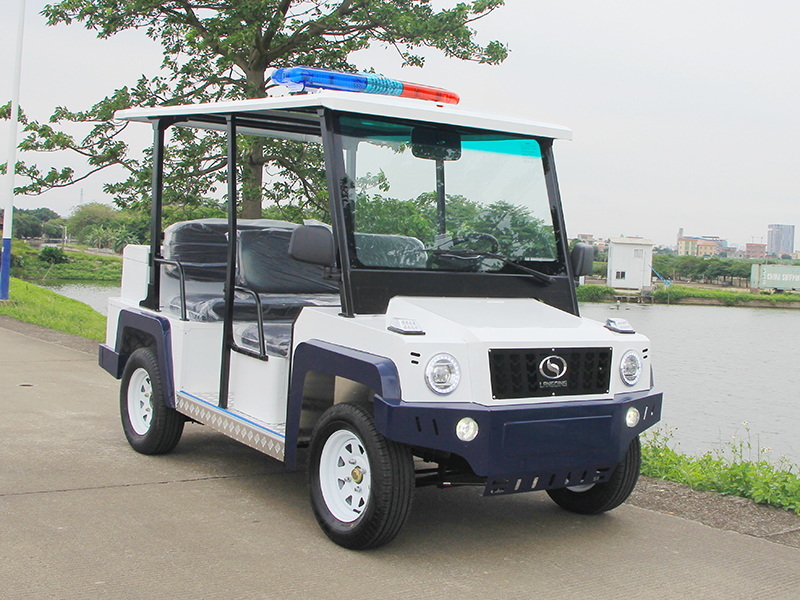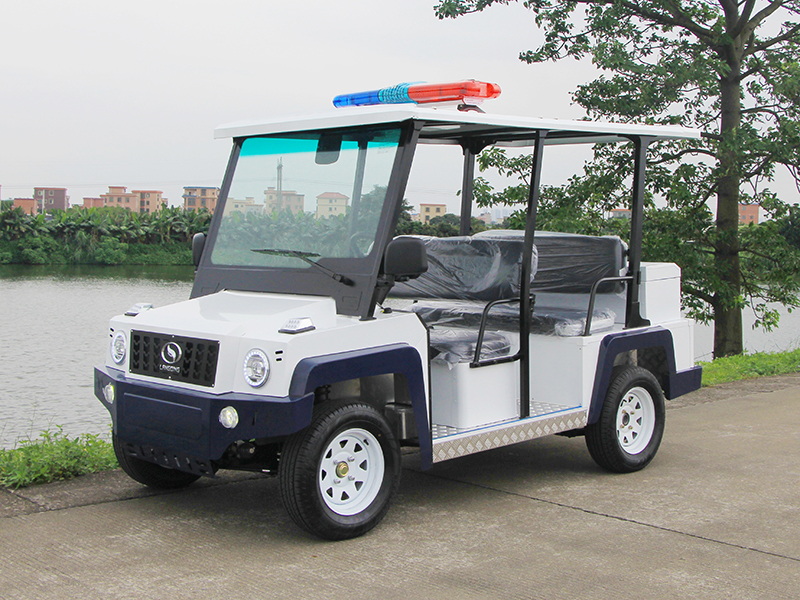Content Menu
● What Are Electric Patrol Cars and Why Are They Important?
● The Evolution of Patrol Cars: From Gasoline to Electric
● Advantages of Electric Patrol Cars
>> 1. Superior Performance and Responsiveness
>> 2. Environmental Benefits
>> 3. Lower Operational and Maintenance Costs
>> 4. Enhanced Technology Integration
● Real-World Adoption and Case Studies
● Challenges in Transitioning to Electric Patrol Cars
>> 1. Charging Infrastructure
>> 2. Range and Recharging Time
>> 3. Initial Cost and Training
>> 4. Battery Degradation and Lifecycle Management
● The Role of Electric Patrol Cars in Community Policing
● Future Trends in Electric Patrol Cars
● Conclusion
● FAQ
>> 1. What is an electric patrol car?
>> 2. Are electric patrol cars reliable for police work?
>> 3. What are the main benefits of electric patrol cars?
>> 4. What challenges do police departments face when adopting electric patrol cars?
>> 5. How do electric patrol cars impact community policing?
As law enforcement agencies worldwide seek to modernize and adopt sustainable practices, electric patrol cars are emerging as a transformative force in policing. These vehicles offer numerous advantages over traditional gasoline-powered patrol cars, from environmental benefits to operational efficiencies and enhanced performance. This article explores the rise of electric patrol cars, their impact on law enforcement, technological innovations, challenges faced, and why they may well be the future of public safety.

What Are Electric Patrol Cars and Why Are They Important?
Electric patrol cars are specially equipped police vehicles powered entirely or primarily by electric batteries instead of internal combustion engines. They are designed to meet the rigorous demands of law enforcement, including rapid response, patrolling, and emergency operations.
Patrol cars are essential tools for law enforcement agencies, enabling officers to maintain public safety, respond swiftly to incidents, and deter crime. The shift to electric patrol cars reflects a broader commitment to sustainability and efficiency in policing.
The Evolution of Patrol Cars: From Gasoline to Electric
Traditionally, police fleets have relied on gasoline or diesel-powered vehicles. However, growing concerns about carbon emissions, fuel costs, and environmental impact have accelerated the transition to electric patrol cars. Modern electric patrol cars combine advanced safety features, superior performance, and eco-friendly operation, aligning with the evolving needs of law enforcement agencies globally.
The evolution is also driven by technological breakthroughs in battery capacity, electric drivetrains, and vehicle design, which have made electric patrol cars more practical and appealing. Governments and municipalities are increasingly incentivizing the adoption of electric vehicles (EVs), including police fleets, through grants, subsidies, and infrastructure development.
Advantages of Electric Patrol Cars
1. Superior Performance and Responsiveness
Electric patrol cars deliver instant torque, providing rapid acceleration crucial for pursuits and emergency responses. Vehicles like the Tesla Model Y and Ford Mustang Mach-E outperform many internal combustion engine (ICE) vehicles in speed and handling, offering law enforcement officers enhanced control and reliability during critical moments.
Moreover, electric motors provide a smoother and quieter ride, which can be advantageous during stealth operations or community engagements. The regenerative braking systems extend the vehicle's operational efficiency and reduce wear on brake components, further enhancing reliability.
2. Environmental Benefits
Electric patrol cars produce zero tailpipe emissions, significantly reducing the carbon footprint of police fleets. This contributes to improved air quality and aligns law enforcement with municipal and global sustainability goals, reinforcing their role as community leaders in environmental stewardship.
By adopting electric patrol cars, police departments demonstrate a commitment to combating climate change and promoting public health. This shift also supports compliance with increasingly strict emissions regulations and helps cities meet their carbon neutrality targets.
3. Lower Operational and Maintenance Costs
With fewer moving parts, electric vehicles require less maintenance—no oil changes, fewer brake replacements, and no exhaust system repairs. Additionally, electricity is cheaper than gasoline, resulting in substantial cost savings over the vehicle's lifespan. Some departments have reported savings of thousands of dollars annually by switching to electric patrol cars.
These savings can be redirected toward other critical law enforcement needs such as training, technology upgrades, or community programs. Furthermore, electric patrol cars tend to have longer service lives, reducing the frequency and cost of fleet replacement.
4. Enhanced Technology Integration
Electric patrol cars are often equipped with state-of-the-art technology, including advanced navigation systems, automated license plate readers, and integrated communication tools. Their electric platforms facilitate the addition of emerging technologies such as drones or robotic systems, enhancing surveillance and operational capabilities.
The digital architecture of electric vehicles allows for over-the-air software updates, ensuring patrol cars remain up-to-date with the latest security patches and performance improvements without requiring visits to service centers. This connectivity also enables real-time diagnostics, helping fleet managers monitor vehicle health and optimize maintenance schedules.
Real-World Adoption and Case Studies
Several law enforcement agencies have already integrated electric patrol cars into their fleets with positive results:
- The Eagan Minnesota Police Department partnered with Dakota Electric Association to deploy a Tesla Model Y as a patrol car. Officers praised its speed, handling, and cost efficiency, noting significant fuel savings and operational benefits during a year-long trial.
- The Los Angeles Police Department (LAPD) has begun testing electric patrol vehicles, including the Ford Mustang Mach-E, to evaluate their performance in urban environments. Early feedback highlights the vehicles' quiet operation and lower maintenance requirements.
- Departments using electric patrol vehicles report that these cars meet or exceed the demands of police work, including range, speed, and ruggedness, proving their readiness for duty.
- The Tesla Cybertruck is being customized for law enforcement use, offering a durable electric pickup option for patrol duties, although specialized SWAT operations still rely on heavier armored vehicles. The Cybertruck's robust design and off-road capabilities make it suitable for rural and tactical applications.
These case studies demonstrate that electric patrol cars are not just experimental but practical tools already enhancing policing effectiveness in diverse environments.

Challenges in Transitioning to Electric Patrol Cars
1. Charging Infrastructure
A key hurdle is establishing a reliable and widespread charging network to support patrol operations. Law enforcement agencies must collaborate with local governments and private partners to install strategically located charging stations to ensure vehicles remain operational throughout shifts.
Some departments have implemented fast-charging stations at police precincts and fleet garages, allowing vehicles to recharge quickly between shifts. However, rural and remote areas may face greater challenges in infrastructure deployment, requiring innovative solutions such as mobile charging units or solar-powered charging stations.
2. Range and Recharging Time
While battery technology has improved, electric patrol cars still require periodic recharging. Departments must plan for downtime and shift scheduling to accommodate charging needs, which can be mitigated by overnight depot charging and efficient fleet management.
Emerging battery technologies, such as solid-state batteries, promise longer ranges and faster charging in the near future, which will further alleviate these concerns. Additionally, hybrid electric patrol cars can serve as transitional solutions, combining electric efficiency with gasoline backup.
3. Initial Cost and Training
Electric patrol cars often have higher upfront costs than traditional vehicles. Additionally, officers require training to operate these vehicles effectively, especially in high-speed pursuits or emergency scenarios. Overcoming skepticism within law enforcement ranks involves education and demonstrating the vehicles' capabilities.
Training programs now include electric vehicle handling, emergency procedures specific to battery-powered vehicles, and maintenance basics. Departments that invest in comprehensive training report smoother transitions and higher officer confidence in electric patrol cars.
4. Battery Degradation and Lifecycle Management
Another consideration is battery degradation over time, which can affect vehicle range and performance. Law enforcement agencies need strategies for battery health monitoring, replacement, and recycling to ensure fleet sustainability.
Some manufacturers offer battery warranties and recycling programs, helping departments manage lifecycle costs and environmental impact effectively.
The Role of Electric Patrol Cars in Community Policing
Electric patrol cars contribute positively to community relations. Their quiet operation reduces noise pollution, fostering a less intimidating police presence. This aligns with community policing principles, promoting approachability and trust between officers and residents.
The visible commitment to sustainability also resonates with environmentally conscious communities, enhancing the police department's public image. Electric patrol cars can serve as mobile ambassadors for green initiatives, participating in community events and educational programs.
Furthermore, the reduced operational costs of electric patrol cars can free up resources for community outreach and social programs, strengthening the bond between law enforcement and the populations they serve.
Future Trends in Electric Patrol Cars
- Extended Range and Battery Improvements: Ongoing advancements in battery technology will increase patrol car range and reduce charging times, making electric vehicles even more practical for law enforcement.
- Integration with Smart City Infrastructure: Electric patrol cars will increasingly connect with smart city systems, enabling real-time data sharing, enhanced situational awareness, and coordinated emergency responses.
- Expanded Use of Electric Police Trucks: Vehicles like the Tesla Cybertruck will become more common for patrol duties requiring larger cargo or rugged terrain capability.
- Incorporation of Autonomous and Robotic Technologies: Electric platforms facilitate the integration of autonomous driving features and robotic devices for surveillance and assessment, enhancing officer safety and operational efficiency.
- Renewable Energy Integration: Police departments may pair electric patrol cars with renewable energy sources such as solar or wind power to create fully sustainable fleet operations, reducing reliance on grid electricity and further lowering environmental impact.
- Enhanced Data Analytics and AI: The data generated by electric patrol cars can be leveraged using artificial intelligence to optimize patrol routes, predict crime hotspots, and improve resource allocation.
Conclusion
Electric patrol cars represent a significant evolution in law enforcement, offering a blend of sustainability, performance, and operational efficiency. While challenges such as charging infrastructure and initial costs remain, ongoing technological advancements and successful pilot programs demonstrate that electric patrol cars are not only viable but advantageous for modern policing. As agencies continue to adopt these vehicles, they set a precedent for environmentally responsible, community-focused law enforcement, driving toward a greener and more effective future in public safety.

FAQ
1. What is an electric patrol car?
An electric patrol car is a police vehicle powered by electric batteries instead of traditional gasoline or diesel engines, designed for law enforcement duties such as patrolling, emergency response, and public safety.
2. Are electric patrol cars reliable for police work?
Yes. Multiple police departments have reported that electric patrol cars meet the demands of speed, range, and durability required for routine patrols and emergency situations.
3. What are the main benefits of electric patrol cars?
They offer superior acceleration, lower operational and maintenance costs, zero emissions, reduced noise pollution, and enhanced technology integration compared to traditional patrol cars.
4. What challenges do police departments face when adopting electric patrol cars?
Challenges include the need for adequate charging infrastructure, managing vehicle range and recharging times, higher upfront costs, and training officers to operate electric vehicles effectively.
5. How do electric patrol cars impact community policing?
Their quiet operation and eco-friendly nature foster a less intrusive police presence, improving community relations and supporting principles of community-oriented










































